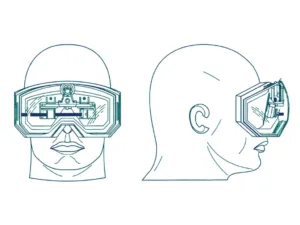By all reports, Apple is determined to follow Meta with a mixed reality (MR) headset with camera passthrough, starting at about $3,000 in 2023, and potentially going down to a cheaper version for $1,500 in 2024 or 2025. Despite the market for VR having a significant number of dedicated followers, it is still small compared to the smartphone market and primarily serves teenagers, young adults, and mostly males. For the sake of consistency, I will use the term MR here throughout my article, but it could equally apply if I was using optical AR, VR, or XR (either optical or camera passthrough).
Maybe, Apple sees its headset as a stepping stone to a new paradigm in the way people use computers, but I would argue that it is a market driven by fear of missing out (FOMO) since the introduction of Google Glass in 2012. Google invested $500 million (in 2014) on Magic Leap (first shipped in 2018), and a series of investors followed, which led to industry hype including Microsoft Hololens in 2016, that augmented reality was the next big thing after mobile phones. Here we are today with Apple’s CEO, Tim Cook, enthusiastically endorsing the company’s investments in MR technology as a game changer.
As a technology enthusiast, I have been following the rumors about Apple’s plans for its own device. The company seems to be under pressure to not appear outdated in this field, and I continue to question their depth of conviction. In contrast, at Meta, Mark Zuckerburg seems to be the lead evangelist of their MR efforts. While Apple has the resources to cover its bets just in case Meta is right, neither Meta nor Apple’s money can buy different physics or make them immune to multiple major MR human factor issues.
While there are tangible benefits with MR today in enterprise applications, I don’t think it will be within the orders of magnitude of the iPhone business. The Pokémon Go games—that have been successful in the past when the cost of the device was “free” with a person’s smartphone and lit up people’s imaginations—are not representative of the potential for widespread adoption. Niantic has struggled with follow-on games like Harry Potter Wizard’s Unite which was eventually canceled. I think Apple will ultimately have to come to terms with the fact that its entry into the market alone can’t drive the number of people that will deal with the technology in its current state, enough for Apple to have a market that will not embarrass them.
The Limits of Physics and Human Factors in AR Technology
Apple is facing the same technical and human factor challenges as everyone else. There’s a concern that they could end up like Google, Meta, and Microsoft and make a costly mistake. As far back as 2019, I have been saying, all of Apple’s money won’t buy them different physics. The challenges facing AR technology are largely rooted in physics and human factors, particularly with the limited wavelengths of light that humans can perceive and the small size of the displays. As Meta’s Michael Abrash stated in 2017, “there is no Moore’s Law for optics, batteries, weight, or thermal dissipation.” The laws of physics may make it difficult to ever create all-day (optical) AR glasses, and a number of major breakthroughs will be necessary to achieve this goal. Factors like diffraction and etendue, which are non-issues for larger displays, become major factors in MR optics. Camera Passthrough MR is also not a panacea and has a massive human factor, social, and safety issues when you get beyond the bounds of a single relatively safe room.
Moore’s Law and Mixed Reality
The learning curve for MR technology is slower than that of semiconductors, as many factors are nearing the limits of physics. The history of optics, dating back to Galileo and his 1610 telescope, is an example of a slower learning curve that has already evolved significantly. The improvements in AR technology will require not just manufacturing but also R&D efforts, and larger expenditures will be needed to achieve the same percentage of improvement as time goes on.
While Moore’s Law is a spectacular example of a learning curve in semiconductors, the learning curve in optics and displays is much slower. The evolution of optics and the limits of physics suggest that the learning curve for MR technology will be slower. Apple is not above the laws of physics and that has to be the starting and end point of every argument.
Karl Guttag is a named inventor on 150 issued US Patents including key patents related to display devices, graphics/ imaging processors, graphics interface circuits, microprocessors, signal processing (DSP), Synchronous DRAMs, and video/graphics DRAM. Since 2011, his blog, KGOnTech (www.kguttag.com), has analyzed consumer display devices and systems.

